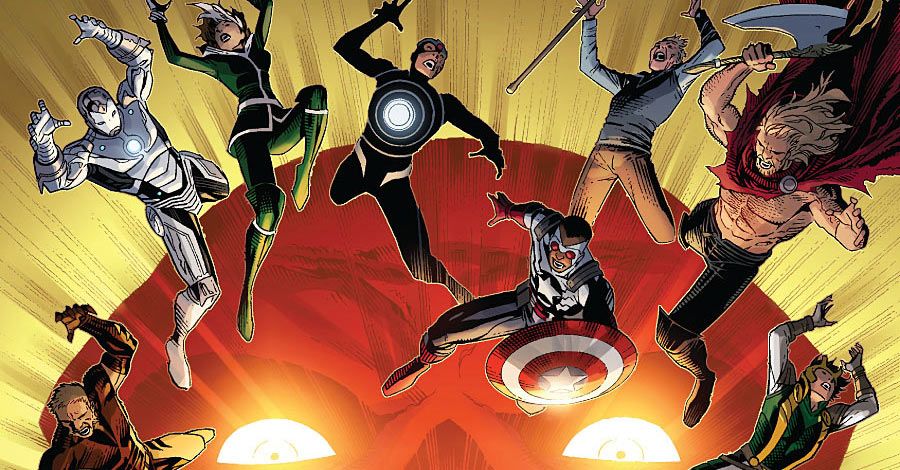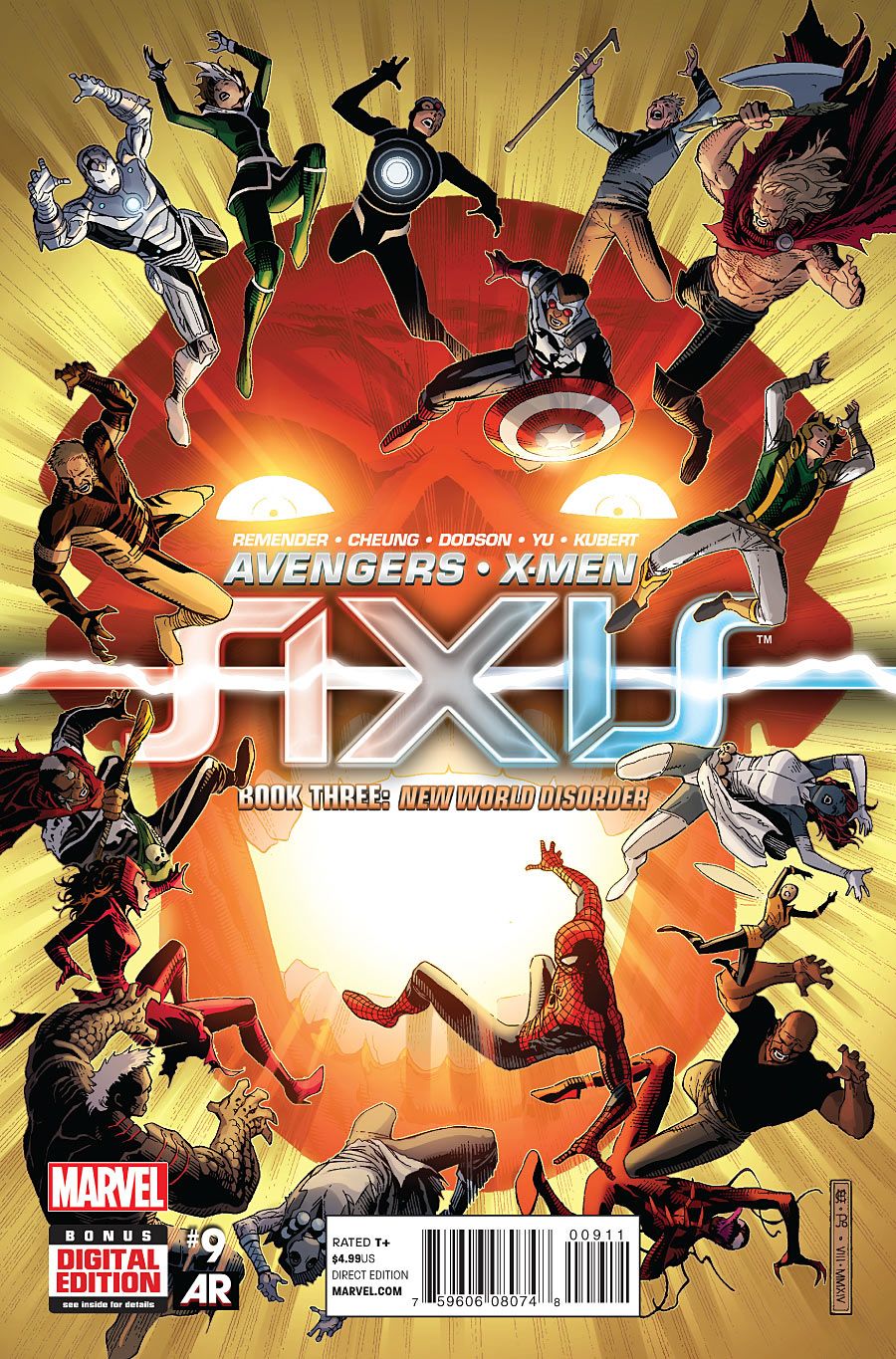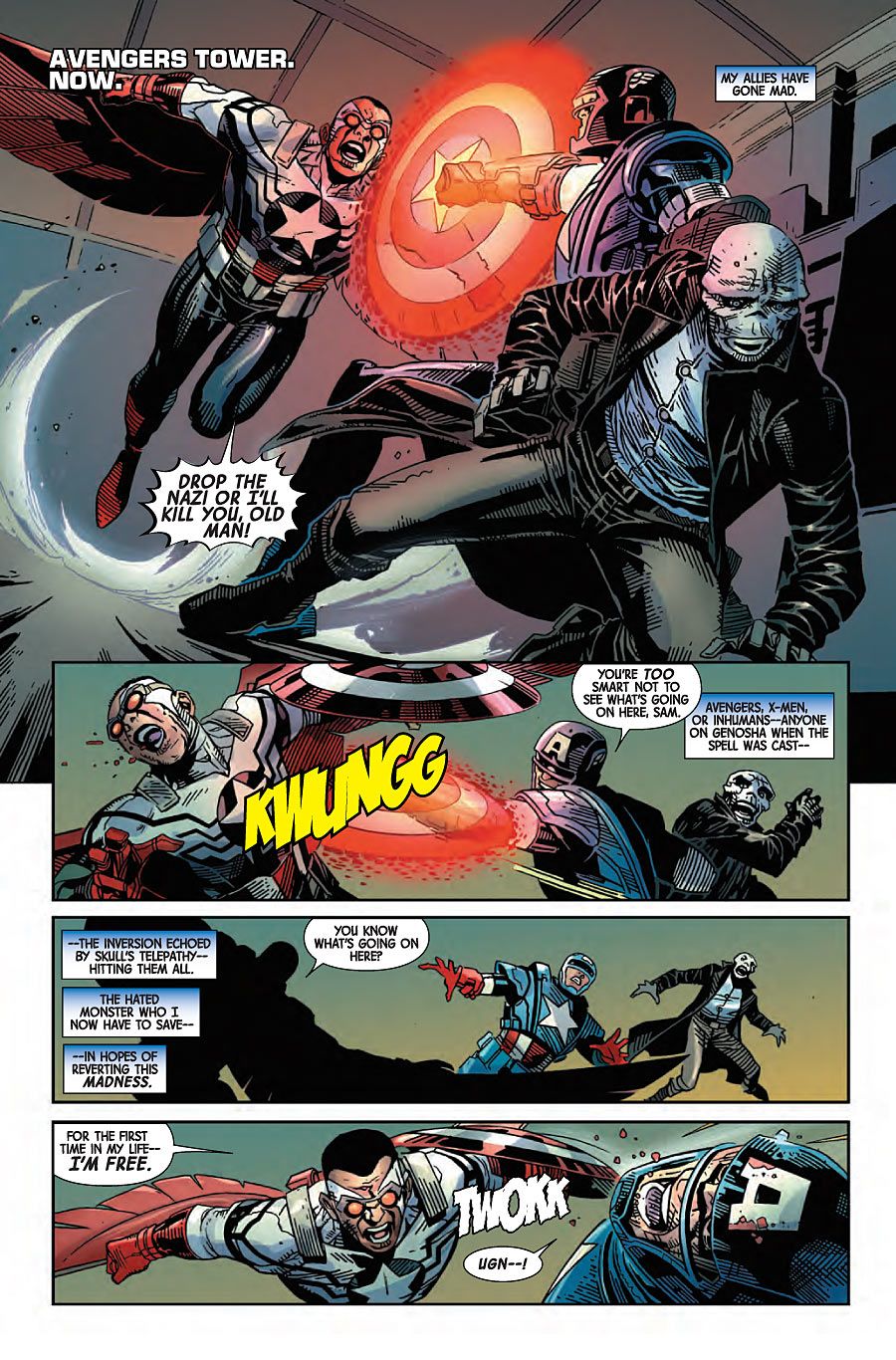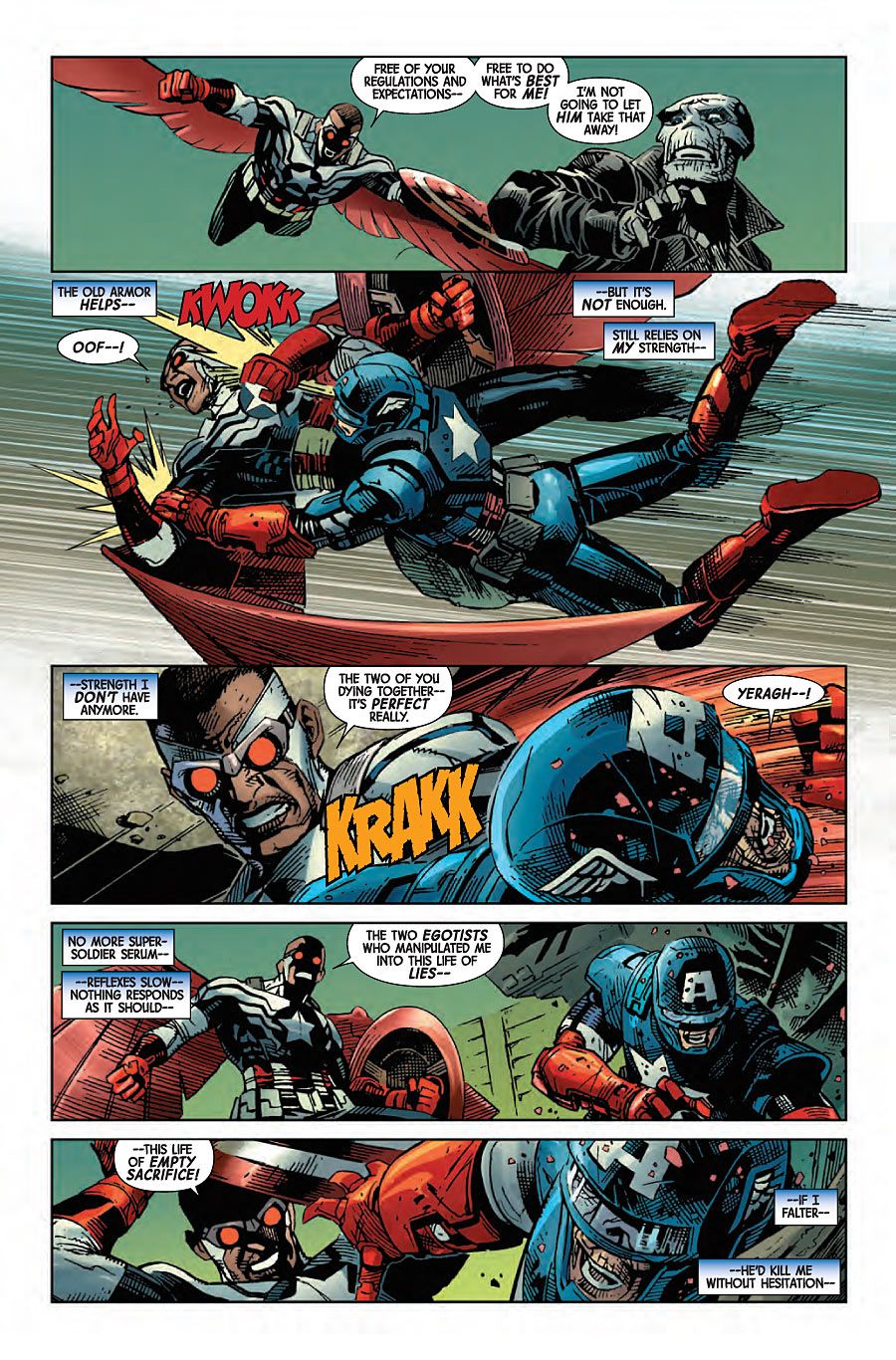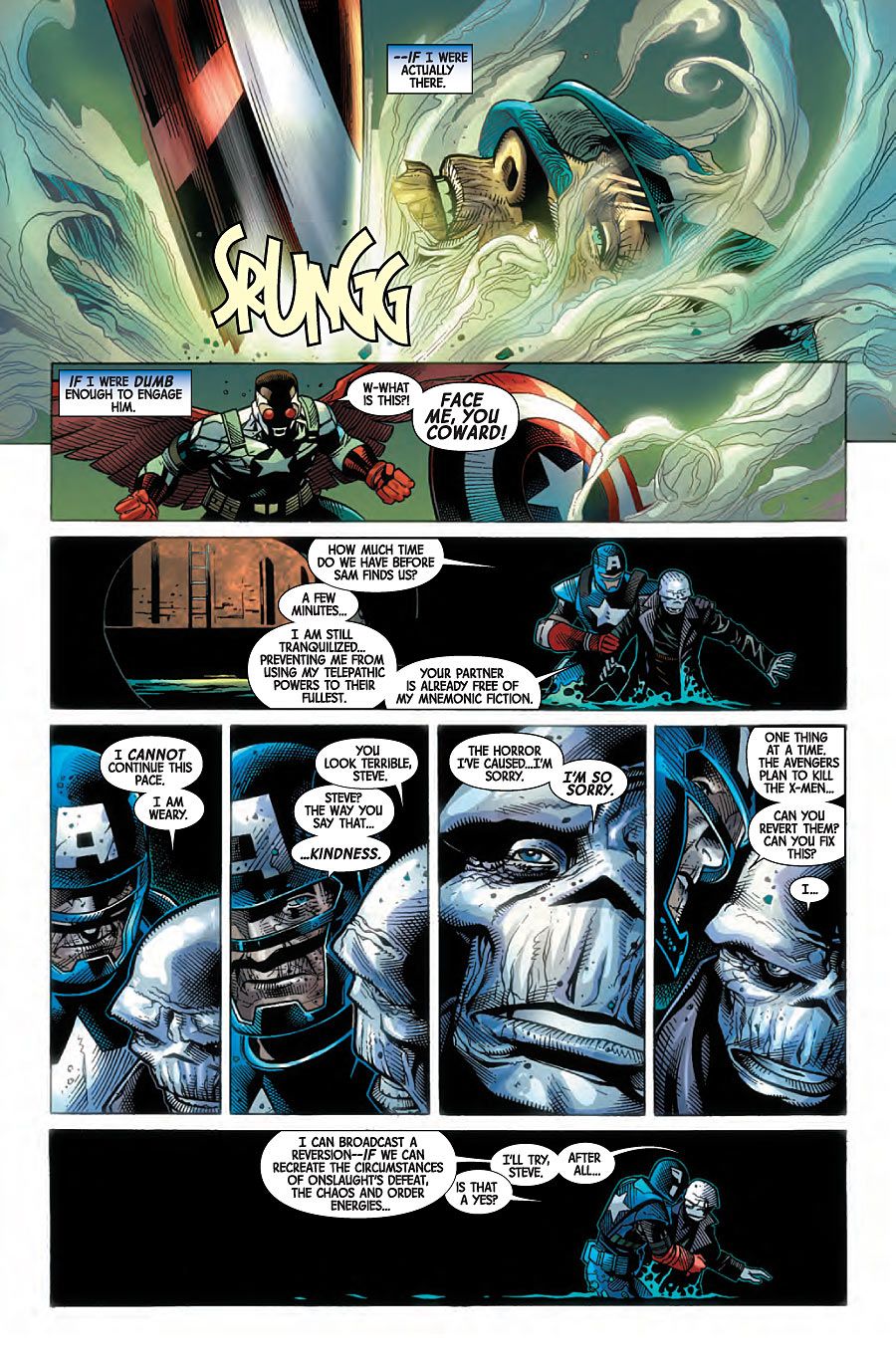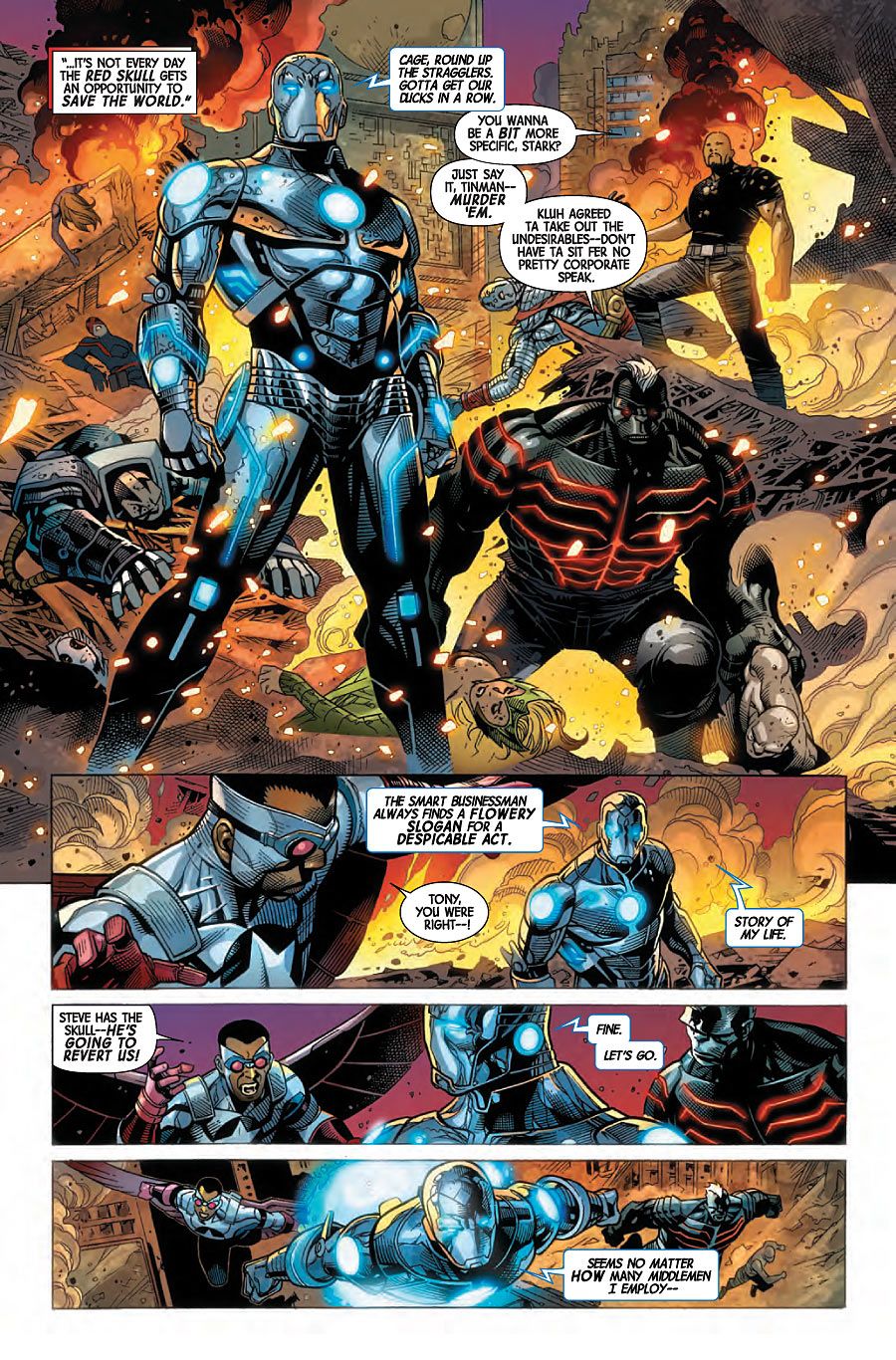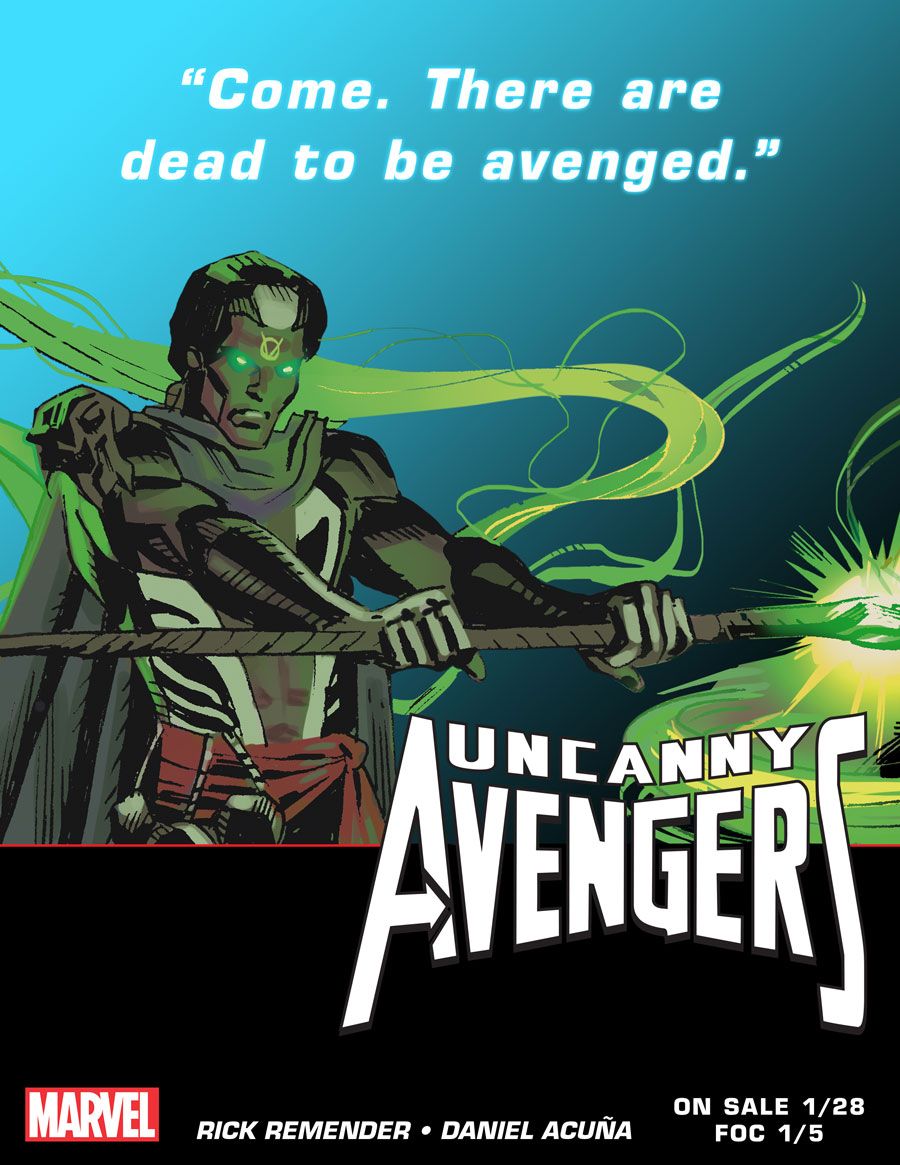When you live in a world where heroes and villain can literally change and reshape reality itself, it's more important than usual to not only examine a person's motives, but the means through which they achieve their goals. The pursuit of a selfish desire can lead to the deaths of countless innocents, especially if it's cloaked in the guise of a noble delusion, and when innocent lives must be sacrificed to achieve a better world, is the blood-stained utopia that arises truly worth the sacrifice required to achieve it?
These larger moral questions about selflessness and selfishness were some of the central ideas explored in Marvel's "Avengers & X-Men: AXIS," which saw a magical inversion spell led a number of heroes to pursue their own egomaniacal goals, while several villains changed their ways and worked for the betterment of their fellow men. The series, and most of these role reversals, came to an explosive conclusion in issue #9, under the guidance of writer Rick Remender and artists Jim Cheung, Leinil Yu, Adam Kubert and Terry Dodson.
RELATED: Tom Brevoort on "AXIS" #8's Heroic Returns & Surprising Revelations
In this, our final ALL AXIS PASS, Remender and Marvel Executive Editor and Senior Vice President of Publishing Tom Brevoort join us for a conversation about "AXIS" #9, the series' larger themes, the characters that remained inverted once the dust settled and smoke cleared, and how the aftermath of the event leads into the launch of the next volume of "Uncanny Avengers." Also -- join us in wishing a Happy Anniversary to Tom, who celebrates his 25th year with Marvel this week!
CBR News: You guys started the journey towards "Avengers & X-Men: AXIS" together in "Uncanny Avengers" #1. Hows does it feel to have that journey come to an end with the final chapter having transformed into the big Marvel event that was "AXIS?"
Rick Remender: It's good to have it wrapped. We had a lot of big, crazy ideas. It was a lot of fun getting to do things like Onslaught, the White Skull and the Cap armor. [Laughs]
Tom Brevoort: [Laughs] I knew you were going to say the Cap armor. I was waiting for it.
Remender: I don't believe anybody has written more Cap than Mark Gruenwald or ever will, and the Cap armor is one of those things like Onslaught. It's a relic from the '90s that is so silly and seems like one of the very last toys you'd want to pull out of the chest, but those are the ones I have the most fun trying to find a way to use that's hopefully satisfying and has that sort of "kitsch" element that makes people smile, and at the same time hopefully is dramatic enough that the silliness is not telegraphed.
Brevoort: It's also one of those things where, with the passing of time and generations, you're now talking about a core audience, many of whom started reading comics during the '90s. So to them, the Cap armor is way more nostalgic because when they encountered it they were like eight years old and it was like the coolest thing ever, even though other people might think it's dopey.
Remender: Yeah, that's something that I recognized working on "Uncanny X-Force," "Punisher," and "Venom." The Punisher hit a sweet spot for me in the '80s, but by the '90s, I was old enough that Venom and X-Force weren't things that I was hugely in love with. Once you dig into those characters and concepts though, and you do your best to tell a good story with them, there are a lot of people who are very appreciative of that effort because of that nostalgia.
How did becoming a Marvel Universe event change "AXIS?" Was the three act structure and what it involved part of your original plan?
Remender: The story went through a lot of different mutations. It was originally going to be an "Uncanny Avengers" story exclusively. I was talking about the plans at a retreat, and a number of other people picked up on interesting things we could do with the high concept and it kind of boiled over. It started as a five issue "Uncanny Avengers" mini-event, and then as we added on little things, month by month, the snowball started rolling down hill and it grew and grew.
Brevoort: It was going to have the Living Tribunal in it!
Remender: No, it was the In-Betweener. [Laughs]
Brevoort: [Laughs] Yes, it was! I'm sorry I misremembered that.
The main focal point of "AXIS" was the inversion storyline, which saw inverted heroes becoming selfish and self-centered, and villains becoming selfless. At the end of the series, Sabretooth writes about how being self-centered and not caring how you achieve your goals is villainy, while setting an example and trying to be something better than that is heroism. Rick, is that sort of a theme in your larger Marvel work? When we recently talked about Baron Zemo's role in "All-New Captain America," you talked about how Zemo's potential for good is often overwhelmed by that self-serving streak in all of us that is difficult to suppress.
Remender: Sure. It's an interesting part of the cognitive dissonance of people who do things that are vile. I think most of them have rationalized the end goal. It's that classic "ends justifying the means" mentality that leads to most human villainy. That's sort of how I see it.

It's something that I find interesting exploring in various characters. Zemo is someone who has played a number of roles in the Marvel Universe. He shouldn't be somebody who is solely out for evil purposes; he should have something in mind that makes him feel like what he's doing is for the greater good, or he sees some reason for it being necessary. It's just that he's also incredibly self-serving, and the ends he uses are going to take a toll on a lot of innocent people.
Your challenge with any villain or hero, really, is to make sure that they're not so good or so evil that they become caricatures. You want to insert things into these characters' motives that are somewhat relatable. How they achieve their goals is where you go to show their true villainy, I think.
The "ends justify the means" mentality has been explored in a lot of your Marvel work from "Punisher," to "Uncanny X-Force," to, now, this.
I don't know if that's been the predominant theme in all my Marvel work. I think that "[Uncanny] X-Force" was more a debate about capital punishment. I thought that was an interesting topic to tackle in a book about people who are actively out to murder villains. "Punisher" was a lot about investigating the monster within Frank Castle. When he had the opportunity to get his family back and instead sends them back to their graves, you have to wonder if he's become the thing that he hates.

Themes have also changed throughout arcs. Obviously, the Apocalypse Twins storyline in "Uncanny Avengers" was all about earning the unity; that the X and the A didn't just come together and hug and say, "Friends now." There needed to be consequences for their inability to work together.

That was sort of a macro look at the Left and the Right and the various factions in our country at this time of partisan divide and the fact that if people can't find middle ground, we're going to implode. That's maybe a reaction to a Congress that won't do anything the President wants and a government in gridlock around the time of writing it.
I think we always try to say something with each one of these things. We always try to have it be that classic Marvel "World Outside Your Window" style so these things are relatable, but obviously, yes, there is a running theme about the motives behind why people do things and the cognitive dissonance between what they think they're doing something for and the rationalization.
The ends justify the means is a very simple concept, and I've met some terrible people, but none of them ever think they're terrible.
Brevoort: HEY! HEY!
Remender: [Laughs] Excluding Tom, who knows. He knows he's quite wicked.
Let's move from larger themes to some of the fallout from "AXIS" #9. At the end of the issue, Tony Stark employs a force field-style device that keeps him, Sabretooth and Havok from reverting back to their pre-inversion selves. Editorially, why were these three characters chosen to stay inverted?
Brevoort: They were characters we had stories for where they remained in that state. Certainly, "Superior Iron Man" and the work Tom Taylor and his editor Mark Paniccia are doing over there have plenty more stories that can be explored. It's an interesting take on Tony Stark, Iron Man and what they mean. Plus, while Tony is inverted, he's almost a throw back to the Tony Stark who was walking around before he got hit with the shrapnel and became Iron Man. So it's a slightly different thing. He's not a literal mustache twirler, but he's suddenly a more unpredictable and fascinating character if he's sort of in that state.
Then, with Sabretooth and Havok, we have future stories planned for them in "Uncanny Avengers" and elsewhere. So them staying the way they are fit into what the next thing is.
There are big plans in the X-Universe for Havok. They'll have ramifications for all of the mutants, in a spectacularly huge way. At the end of "AXIS" #9, we see Havok and his brother Scott reunited. Havok is still inverted, and that might fall in line with Scott. So the Summers brothers are reunited and are going to get up to some stuff.

As for how much of that I'll actually be writing -- all I can say is, wait and see. I have plans, and there are things in the works.
Speaking of mutants, at the end of "AXIS" #9 the collected inverted villains release a statement declaring that they were responsible for all the trouble the inverted X-Men and Apocalypse caused in New York. How much trouble would the mutants be in if the truth of what really happened came to light?
Brevoort: It wouldn't just be the X-Men that was in trouble -- it would be everybody. It's not like things would be any better for the Avengers. Thor went on a bender in Vegas, and Sam Wilson was putting people in the hospital while in his Captain America identity. Certainly, the X-Men did the biggest thing by kicking everybody out of Manhattan, and working with Apocalypse to try and set off that big bomb, but it's not like anyone else would come out smelling like a rose either.
Remender: That was something that Tom hit on while we were cooking this up. What made it all work was that these inverted villains ultimately made the sacrifice, even knowing that they'd go back to being dirt bags. Not only would they go fight this fight and put the pieces together to try and revert themselves, but they also film that video to take credit for all of it and take all of the blame making all of their lives far more difficult than they had been. Taking credit for the entire thing was a very heroic gesture and something that both played into the whole thing and cemented the landing, I think.
The inversion spell that reverts the heroes back to normal is cast once again by Doctor Doom and the Scarlet Witch, who is being possessed by the spirit of Daniel Drumm. Which leads me to wonder, we saw Doctor Strange in Act One of "AXIS," but I don't believe we've seen him since. Tom, is there a story there about that we'll see some time soon?
Brevoort: Um -- No. [Laughs] I could have faked it there, but no, there's not.
Remender: The idea was that Strange was among the heroes that got shrunk down into the ant farm. Obviously, Terry couldn't draw every single character in the Marvel Universe in that scene, but the idea was that they had called together all of the heroes for that meeting and then the trap was sprung and they shrunk them all down. The only two who escaped were Spider-Man and Nova.
Plus, one of the gets was that Doctor Voodoo had to play an important role. The story that we haven't seen that will be unearthed is, if you read my "Doctor Voodoo" miniseries, you saw the relationship between Doctor Doom and Jericho Drumm. So it made perfect sense for Doom to be the one to call forth Voodoo from whatever realm he was imprisoned in. I don't want to give any of that away, because I think there's a story there that we'll get around to eventually, or someone will.
It all ties together very cleanly when you know Doom and Jericho have a tight relationship, that they've been through many things together, and that Daniel is ostensibly the only one powerful enough to possess somebody like Wanda in the state that she was in. It was important that it all made sense and it wasn't just us saying, "We're bringing Voodoo back." There was a logical reason to have him back, between Doom, Wanda and the possession.

It all worked out, and Voodoo was obviously a character I liked quite a bit. Tom does as well, and we have plans for him to do some very cool things in the future.
Let's talk about the work done on "AXIS" #9 by Jim Cheung, and Adam Kubert, Terry Dodson and Leinil Yu, who returned to assist Jim with the issue. Rick, what was it like writing for all these great artists in the same issue? And how did you decide which portions of the issue Leinil, Terry and Adam would contribute to?
Brevoort: Taking the last bit first, some of that really just boiled down to being honest about how fast Jim was able to be. The original plan was to have Jim do the entirety of this issue. It didn't work out that way, so we tried to relieve some of his burden in a way that made sense.
It made sense for Terry to do the epilogue/finale, both because of the actual story content that it had and because, for lack of a better term, he has a more upbeat and more bouncy style. The idea that the clouds part, the sun comes out and things are restored was really a Terry thing. Also, though, on a real practical level, he was the first guy to be done because his issues were #5-6, and he wasn't really scheduled to come back for another full issue.
Leinil doing the opening page with Wolverine and Sabretooth was good in that he's got history with Wolverine. He's very comfortable with the character, and seeing him draw the classic Wolverine in the brown suit and Sabretooth feels right, because he's drawn those characters and been connected with them going back decades, to the point where they more or less looked like that.

Adam's page was literally just that we needed to take the pressure off Jimmy for one more page. It happened to be that one, and Adam was game to step up and take on one more page at the 11th hour.

It's not that Jim fell down. This is an incredibly difficult last issue to do. There's a lot of characters, and there's a lot of pages. This was a terrific team effort from a group of guys who all along have been sharing pages and competing, but also working together. It was kind of nice that they all could be represented in the finale.
Remender: I also think that it worked out really well in that the opening is a flashback, so the art changes. Then, the close out is something that Terry does. It's a different sequence, so it doesn't feel jarring. And Adam did a great job of adding a page into Jimmy's stuff. I think that it's all fairly seamless.
It was a huge issue, too. So much had to happen. Jimmy and all the artists really worked to death on this stuff and did an amazing job. Also, I think because we had the same art team shifting and doing the best that they could to link up and marry up, once the book is all collected in a trade paperback, it will have a cohesive feel because of that. It was wonderful that they could all come back for the close out. It makes for a nice book end.
Let's wrap up by offering up some teases about the new volume of "Uncanny Avengers," where we'll see some of the ideas introduced in "Avengers & X-Men: AXIS" like Sabretooth, Doctor Voodoo and the parentage of Quicksilver and the Scarlet Witch. Rick, How will it compare to the previous volume?
Brevoort: [Laughs] It will be much better, and you have to buy it now. Even if you stopped buying it before, you have to buy it now because it's twice as good. It's amazing!
Remender: Yes, it's twice as good now. That's how I'll promote all things in the future. Everything is constantly increasing exponentially in its goodness. [Laughs]
The #1 issue of this new volume of "Uncanny Avengers" is an interesting experiment in that it loosely feeds out of the first series and obviously feeds out of "AXIS." We worked very hard though to make sure that first issue is very new reader friendly.
I also just cut the first issue. I had written and was moving forward when I got to what was going to be the beginning of issue #2, and I cut the first issue. That's something that I've been doing on my creator-owned books a lot. I find the effect is to be sort of dropped into the middle of something. There's almost an excitement to it. It's an infusion of mysteries as to what's going on. Then, by the end page, we get a good idea of what's going on.
This is a story that will begin to shine a light on the mystery as to what, in fact, has gone on with Scarlet Witch and Quicksilver. It was an assignment that I was nervous about taking at first. Then, as Tom and I worked out the story and came up with the sort of foundation that we were going to use, the big villain, and where it all takes place, it became far too interesting. I really fell in love with what we have planned.
The Avengers are scattered around right now, and things are quite chaotic, so this is a team that is drawn together almost by lottery. There's no one drafting recruits for a new Avengers team. It's really Rogue doing her best to pull together the elements that she has available in order to help a friend. That leads us on to an adventure that is [artist] Daniel Acuna's best work to date. That's saying quite a bit, given what he's been doing. It's an absolutely stunning issue, full of strange science fiction and a lot of crazy action.
You mentioned that the Avengers are scattered. Is that because of the divide we saw between the teams in the current "Time Runs Out" storyline running through writer Jonathan Hickman's "Avengers" and "New Avengers?"
Brevoort: No, when we're taking about the divide among the Avengers in this book, we're talking specifically about the divide in the Uncanny Avengers. By the time you get to the end of "AXIS," Havok is gone, the Wasp is gone, Wolverine is dead and we're about at the point where Thor is going to become a woman. So if you look at the cast of the actual "Uncanny Avengers" book up until now, most of them have been through some very chaotic stuff to the point that there's not a lot of the original members left standing, or left standing unchanged.
It's kind of a bad time if a situation arises for which you need the Unity Squad, because there's not a whole lot of them left ready to answer the call. Instead, Rogue will pull together the people that she thinks will be able to assist in this situation and go forward and take on this crazy challenge.
Ultimately, "Avengers & X-Men: AXIS" was a lengthy event story that unfolded quite quickly. Looking back, what was it like to have told a story like this in such a short time period?
Brevoort: We opted to do this in three months! Three issues each in three months, which I think was great in terms of the reading experience of not having to wait a whole lot of time in between issues and having the pace be even more machine gun-like than it normally is. Man, if we had a chance to do it over again though, I'd do it in four months! [Laughs]
None of these things are easy, but this one was especially difficult. It's also because of the months it was released. We were sending these out during the tight times that come with the Thanksgiving holiday and leading up to the Christmas holiday.
Remender: [Laughs]
Brevoort: So we had some merciless schedules. If these exact same books were coming out in, say, April at a pace of three a month, they would have been a lot easier. The circumstances of when we did it made it all the more difficult. It's wonderful that we actually managed to make it to the finish line, and with a story that makes some kind of sense.
Remender: Writing "AXIS" was a lot of fun, but it was obviously very exhausting. No matter how much of this had been front-loaded, I had never juggled anything that had to serve so many masters. It was very eye opening. There was the sheer volume and difficulty of navigating of all the different rain drops, but I couldn't be more proud of the tie-ins we had. I think the event is a success. I'm very happy with it.
Catch up with all nine installments of ALL AXIS PASS!

